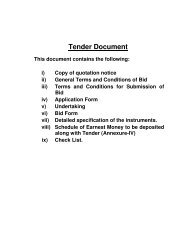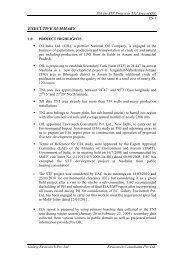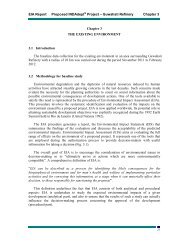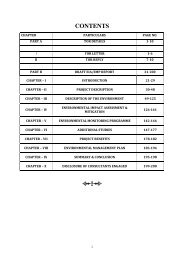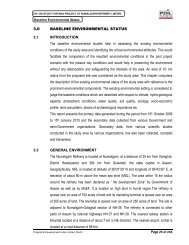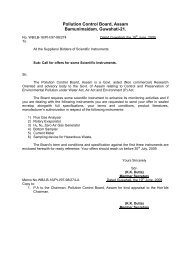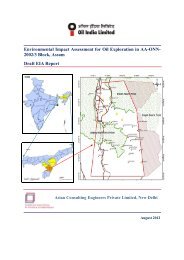Chapter-I - Pollution Control Board, Assam
Chapter-I - Pollution Control Board, Assam
Chapter-I - Pollution Control Board, Assam
You also want an ePaper? Increase the reach of your titles
YUMPU automatically turns print PDFs into web optimized ePapers that Google loves.
EIA Report Proposed INDAdept G Project – Guwahati Refinery <strong>Chapter</strong> 1<strong>Chapter</strong> 1INTRODUCTION1. The Guwahati Refinery1.1 IntroductionGuwahati Refinery is one of the seven operating refineries owned by Indian OilCorporation Limited, and is located among the picturesque surroundings near theBrahmaputra river at Guwahati in the northeast part of India. The refinery processesindigenously available crude of <strong>Assam</strong> and caters to the requirements of the petroleumproducts of the region.Inaugurated on 1 January 1962, Guwahati Refinery is the first public sector refinery inIndia and was built using Rumanian technology available in the late 50s. The originalcrude oil processing capacity of 0.75 MMTPA has been subsequently increased to 1.00MMTPA. The crude oil is supplied from <strong>Assam</strong> fields by M/s OIL INDIA LIMITEDthrough a cross-country pipeline.Besides various processing units, Guwahati Refinery has a captive thermal power station(TPS) inside the refinery that generates and supplies electric power and process steam. TPSconsists of two chains of DM plant, 4 boilers of 20 T/Hour, 1 boiler of 40 T/Hour and 2boilers of 50 T/Hour capacity as well as 2 TGs of 8 MW and other one 12 MW capacity isbeing installed. Three new air compressors are also installed to supply air to the instrumentsand the plant.The other facilities consist of Crude oil, intermediate and product tanks, Hydrogen andNitrogen storage bullets, tank wagon loading /unloading gantry, tank truck loading/unloading gantries, LPG storage and dispatch facilities. There is a well equippedLaboratory and a modern effluent treatment plant besides fresh water supply from the riverBrahmaputra to the Refinery and other end users.The main products currently manufactured in Guwahati Refinery are:‣ Liquefied Petroleum Gas (LPG)‣ Motor Spirit (MS)‣ Superior Kerosene Oil (SKO)‣ Aviation Turbine Fuel (ATF)‣ High Speed Diesel (HSD)‣ Light Diesel Oil (LDO)‣ Sulphur (S)‣ Low Sulphur Heavy Stock (LSHS)‣ Raw Petroleum Coke (RPC)1
EIA Report Proposed INDAdept G Project – Guwahati Refinery <strong>Chapter</strong> 1Guwahati refinery has several credits for its performance and has obtained ISO-9001-2000, ISO-14001 and OHSAS-18001 certification by M/s DNV, Netherlands. GuwahatiRefinery has also achieved level – 6 in International Safety Rating System and 4-star byBritish safety Council, UK.1.2 Process Units1.2.1 CRUDE DISTILLATION UNIT (CDU)The Crude Oil is pumped to unit by the unit feed pumps from the storage tanks at anaverage temperature of 30C and passes through heat exchangers. In the heat exchangers, theincoming feed exchanges heat with the hot stream products, thereby attaining a temperature of200 C before entering the pre-topping column CL-1. The feed entering CL-1 is flashed andthe overhead gases and light gasoline vapours from the top of the column are condensed in theheat exchangers, overhead condensers and enters in the reflux drum. Condensate from refluxdrum goes to LPG stabilizer as feed for LPG production.The skimmed crude at 187 C comes out from the bottom of the column CL-1 andpumped through heat exchangers where it is heated upto 263 C by exchanging heat withRCO coming from CL-2 bottom and Gas oil circulating reflux. Then the skimmed crudeenters first in the convection zone and then the radiation zone of the vertical balanced draftheater.The heated skimmed crude at 363 C is delivered through a overhead transfer line to themain fractionator column CL-2. MP steam at 240 C is introduced at the bottom of thecolumn to strip off lighter fractions from reduced crude oil. The overhead vapour from CL-2is condensed and goes to the NSF Unit as feed along with stabilized gasoline obtained fromstabilizer bottom for Light Naphtha, Reformer Naphtha and Heavy Naphtha production.Two circulatory refluxes of Kero-II & SRGO are withdrawn, cooled and returned to thecolumn for better control of vapour liquid traffic in the column. Three side streams viz. SRKero-I, II & SR Gas Oil are also drawn from CL-2 which enter the stripping column CL-3, inthe different sections. Steam is introduced in all the sections of the column CL-3 to strip offlighter components, which then go back to main fractionators column CL-2.SR Kero-I after exchanging heat with NSF feed, gets cooled to 36 C and goes to therundown tank. Similarly SR Kero-II & SRGO are cooled in crude heat exchangers and then incoolers and sent to respective rundown tanks. Reduced crude from the bottom of CL-2 ispumped through crude oil heat exchangers. Reduced crude oil is then sent to DCU as hot feedor to rundown tank via RCO cooler for storage.1.2.2 NAPHTHA SPLITTER FACILITY (NSF)Naphtha Splitter Facility in Guwahati Refinery was commissioned in 1984 in order tomeet the Reformer naphtha requirement of BGR. The feed stock for the unit is the combinedstabilized gasoline & heavy gasoline of CDU (Combined ASTM range being IBP-130 C).The light gasoline is first stabilized in stabilizer column C-003 & LPG is recovered. Theheavy gasoline ex CDU main-fractionator (CL-2) is received in NSF surge vessel V-001 viacaustic wash vessel V-3. The stabilized gasoline ex C-003 bottom & heavy gasoline ex surgevessel V-001 after getting heated upto 115 C enter splitter one column C-001. From splitter2
EIA Report Proposed INDAdept G Project – Guwahati Refinery <strong>Chapter</strong> 1C-001 top light naphtha having ASTM range IBP-120 C goes to MS pool/ISOSIV Feed &HGU Feed. The heat from vaporization in this column is supplied by routing a part of thebottom product through the reboiler Furnace F-001. The liquid bottom product from C-001 isfurther separated in the second column C-002 giving bottom product as Heavy naphtha withASTM FBP upto 240C (routed to HSD) and Reformer Naphtha (routed to AOD / MS pool).The heat from vaporization in this column (C-002) is supplied by routing a part of the bottomproduct through the reboiler Furnace F-002.1.2.3 DELAYED COKING UNIT (DCU)The feed is RCO and it is directly taken from CDU RCO R/D at 100 Deg C or from tanksat about 90 C. Clarified Oil (CLO) Ex INDMAX is also processed in DCU. Feed pump P1takes suction and discharge passes through feed preheat exchangers, where it gets heated fromabout 254 C. This heated feed then goes into main distillation column partly in vapour zoneabove flash zone and partly in liquid zone below flash zone.The fractionator column bottom material (secondary feed) is pumped to heater by amultistage pump P2/2A.The flow to heater is divided equally into 4 passes at heater inlet.Fractionators bottom is heater upto 501 deg C in the balanced draft heater furnace equippedwith an Air pre-heater. At the furnace outlet BFW injected in all four passes to avoid cokingin transfer line from heater to coke chamber. Process fluid ex heater goes to coke drumsthrough the 4-way valve.In coke chamber cracking and polymerization reactions take place from which Gas, LPG,CGO, CG, CFO& RFO generated along with RPC. Gases containing all products are routedto main fractionator’s flash zone through quench column where CGO reflux is used to quenchthe vapors to avoid further polymerization.The vapors from the quench column 03-CL-1 at about 425 C enters in the flash zone (34trays) of main fractionating column (03-Cl-02. A temp gradient is maintained in distillationcolumn with top reflux. Top temp is maintained at about 90 C and bottom at about 365 C.The products CK-I, CGO & CFO are steam stripped in stripper column (03-Cl-03A/B/C )having 4 trays each. The vapors from strippers are returned to the main column (2 trays abovedraw off) and the liquids are pumped under level control and sent to run down tanks afterexchanging heat and cooling in run down coolers with circulating water.The overhead vapors from main fractionators are cooled in condensers S-2A to E TO 40C and taken to reflux vessel 03-V-0I. The incondensable gases under pressure control goes tofuel gas system/ LPG recovery section. The condensed liquid is partly refluxed back tocontrol column to temp of 40 C and excess liquid under level control goes to Cl-20.1.2.4 LPG RECOVERY UNITIn LPG Recovery Unit Coker off gases are compressed followed by absorption of C-3/C-4components with Naphtha and separation of C-3/C-4 from rich Naphtha in stabilizer. 3 nos. ofreciprocating compressors have been provided with a capacity of 2750 kg/h each forcompressing the coker off gases up to 15 kg/cm . Normally two compressors are in operationand one is standby. The compressed gas after being cooling to 40 C is routed to absorberwith 44 nos. of valves trays. Stabilized gasoline enters 44th tray and unstabilized gasolineenters 40 th tray for absorption of C-3/C-4 components. Condensate generated at interstage /afterstage cooler of compressor is also transferred to absorber. MP steam heated reboiler is3
EIA Report Proposed INDAdept G Project – Guwahati Refinery <strong>Chapter</strong> 1provided at the bottom to stip-off C-1/C-2 components. The rich solvent from bottom of theabsorber is feed to stabilizer column (04-Cl-04) where gasoline is stabilized by removingLPG. From stabilizer top LPG sent to bullets after caustic wash and gasoline from bottom sentto tanks for storage.1.2.5. HYDROTREATMENT FACILITIESHydrotreatment Facilities are installed at Guwahati Refinery for improving the stabilityand Cetane No. of HSD meeting BS-II specification, Smoke point of Kerosene streams andfor upgradation of feed kerosene streams to SKO and ATF. The treatment facilities consist ofthe following units:‣ Hydrotreating Unit‣ Hydrogen Unit‣ Amine Treating Unit‣ Sulfur Recovery Unit‣ Sour Water Stripping Unit(Capacity : 600 TMTPA)(Capacity : 10 TMTPA)(Capacity : 10 M3/hr)(Capacity : 5 TPD)(Capacity : 6 M3/Hr)The Hydrotreating unit (HDT) operates in three blocked out modes of operation, viz.,ATF mode consisting of SR Kero-I, Kerosene mode consisting of SR Kero-I and SR Kero-IIand HSD mode consisting of SR Kero-II. SR Gas Oil, Coker Kero-I, Coker Gas Oil & TCO.Hydro processing technology is a proven and widely used technology licensed by severalreputed licensors like UOP, IFP etc. Guwahati Refinery has opted for UOP’s ‘DistillateUnionfining’ Technology for this unit.For supplying Hydrogen gas to HDT unit, a Hydrogen unit is installed based on SteamReforming Technology of KTI using a mixture of light naphtha (SRN) and off gases ex LPGRecovery Unit (LRU) as primary feed. For providing flexibility in feed composition, a prereformingstep applied upstream of Reformer using steam reforming technology from M/sTechnip, Italy. After the shift conversion, Pressure Swing Adsorption (PSA) process of UOPapplies to produce high purity hydrogen product from raw hydrogen. For supplying hydrogenduring start-up of hydrogen generation unit two hydrogen bullets are installed in the refinerywith flexibility of unloading hydrogen from potable cylinders.In order to remove H 2 S from gaseous feed of Hydrogen unit, the wet gas obtained fromDelayed Coker Unit (DCU) and HDT treated in Amine Treating Unit (ATU) which iscombination of AAU and ARU. Amine Absorbers Unit (AAU) generates rich amine. Thegenerated rich amine from (AAU) is sent to Amine Regeneration unit (ARU) whereStripping of H2S is done and regenerated lean amine. The lean amine is reused in AAU fortreating wet gas obtained from DCU from 5500 kg/hr of DCU and 940 kg/hr of HDT wetgases. The Process licensor of this unit is KTI, BV.As a part of Hydrotreatment Facility, a Sour Water Stripper (SWS) is also install to stripof H 2 S from sour water coming form HDT unit and existing DCU based on UOP’Stechnology. The Acid gas recovered from stripper is sent to Sulfur Recovery Unit.Acid gases from ATU and SWS are fed to Sulfur Recovery Unit (SRU). In SRU, H 2 Spresent in the feed gas gets converted to elemental Sulfur. SRU of Guwahati Refinery is based4
EIA Report Proposed INDAdept G Project – Guwahati Refinery <strong>Chapter</strong> 1on ‘3 Stage Modified Claus Process’ having a single chain of 5.0 TPD capacity. AAU, ARUand SWS are a part of SRU and installed at one place is called Sulfur Block.1.2.6. INDMAX UNITINDMAX unit is installed to maximize LPG and light olefin production from heavypetroleum fractions. INDMAX, Indane Maximization Process, developed by Indian OilCorporation Limited (IOCL) is similar to conventional FCC process. In INDMAX, CokerGasoline and heavy oils such as RCO, CFO are cracked to more valuable light and middledistillates such as LPG, Gasoline and Diesel. The capacity of INDMAX unit is 100,000 TPA.INDMAX unit consists of the following sections:‣ Feed Storage and Pumping Section‣ Reaction and Regeneration Section‣ Fractionation Section‣ Gas Concentration Section‣ LPG/ Gasoline Treatment SectionRCO and CFO will be preheated to 180-220 deg.C in heat exchanger with steam.Preheated feed will contact catalyst at 700 deg C in the riser. On contact with catalyst feedwill get cracked to lighter HC’s and the final temperature will be 585 deg C. Cracked vaporswill be separated from catalyst in the riser and reactor cyclone. Vapors from riser cyclone willgo to main column via vapor line where separation of HC’s in the various streams will takeplace.Main column over heads are separated into Gas, LPG and Gasoline in the GasConcentration section consists of wet gas compressor four columns and set of exchangers andvessels etc. LPG and Gasoline are caustic washed to remove H2S and then water washed toremove entrained caustic. Diesel withdrawn from the column goes to diesel pool as well as forflushing oil after stripping in stripping column.Main part of the main column bottom is recycled to column as quench and wash. Rest ofthe bottom materials is clarified in either slurry settler or slurry filter and sent to tanks asclarified oil.Catalyst from reactor stripper after stripping out entrained HC’s gets back into theregenerator through spent catalyst standpipe. Spent catalyst is regenerated in the regeneratorby combustion of coke formed on the catalyst with air. Specially designed air grid ensuresuniform distribution of air in the regenerator. Air blower supplies air for coke burning.Regenerated catalyst travels back to riser through regenerated catalyst standpipe.Combustion gases form the regenerator at temperature of 730 deg C with catalyst entersregenerator primary and secondary cyclone to knock down the catalyst. Hot flue gases fromregenerator passes through Double Disc Slide Valve to the Orifice Chamber where thepressure of the gases is reduced from 2.5 kg/cm 2 to 0.2 kg/cm 2 . Heat of hot flue is removed inWHB by generating HP Steam.Fresh and equilibrium catalyst are stored in two different hoppers with requisite loadingunloading provision. Apart from these two hoppers automatic catalyst loading system has5
EIA Report Proposed INDAdept G Project – Guwahati Refinery <strong>Chapter</strong> 1been installed from M/s Intercat for smooth catalyst handling and continuous catalyst loading.The unit has a dedicated flushing oil system. Flushing oil is required during the normaloperations as well as during shutdown/ start up.With the upcoming MS quality up gradation project, a 3-cut splitter facility is added inINDMAX unit as Object-55. A combined feed stream of wild naphtha and INDMAX (FCCU)Gasoline is routed to 3-cut splitter column located at eastern side of existing INDMAX unit,wherein the feed stream split up into 3 fractions:‣ Top Cut (Light Gasoline, TBP Boiling Range: C5-70 deg C) High Octane and LowAromatics stream. The same is directly routed to MS pool.‣ Middle Cut (Heart Cut, TBP Boiling Range: 70-90 deg C rich in Benzene, Sulphur,Aromatics and Olefins-hence, cannot be directly absorbed in Euro-III Grade MS pool. Thisstream is routed to 56 unit as feed for NHDT, followed by further treatment in ISOM and DIHsections.‣ Bottom Cut (Heavy Gasoline, TBP Boiling Range: 90-200 deg C) can be absorbed inMS pool or DHDT (Diesel Hydrotreater ) feed.1.2.7. ISOSIV UNITTo produce unleaded gasoline and high octane product, ISOSIV unit is chosen based ontechnology supplied by UOP. The feed of this unit is Light Naphtha (50-140 oC) from NSFand its capacity is 130,000 TPA. In this unit, Normal paraffin in the feed are separated fromNon-normal and aromatics, using molecular sieve beds.It provides a mean for separation of Normal paraffinic components from Non-normals andaromatics of Gasoline boiling range material. Naphtha (Gasoline boiling range) is vaporizedin a furnace and passed through the molecular sieve adsorbent beds. The normal paraffins getadsorbed in the adsorbents while the non-normals and aromatic materials pass through theadsorbent beds. The unabsorbed non-normals and aromatic components of naphtha arecondensed and stabilized in the stabilizer before it is sent as high octane Naphtha (Gasoline).The adsorbed normal paraffins are desorbed from the adsorbent beds by purging with hotHydrogen gas. There are four absorber vessels filled with adsorbents. At any time ofoperation each adsorber vessel will be at different stages of adsorption and purging mode ofoperations.Each step is essentially a batch operation. However, the piping and sequencing valvesallowing flow into or out of each absorber are designed to permit continuous separation of thenormals from the adsorber feed streams.Subsequently, the purged out normal paraffins and Hydrogen gas are cooled, normalparaffins get condensed and separated from Hydrogen gas in a separator. The separatednormal paraffins are stabilized in a stabilizer before it is sent as normal paraffins/ naphthaproduct.1.2.8 ISOM UNITStraight Run Light Naphtha Splitter Column, a Naphtha Hydrotreater (NHDT), anIsomerisation Unit (ISOM) and De-Iso-Hexanizer (DIH) Column have been installed inISOM unit for production of Euro-III Grade MS in Guwahati Refinery. New Light Naphtha6
EIA Report Proposed INDAdept G Project – Guwahati Refinery <strong>Chapter</strong> 1Splitter, NHDT, ISOM and DIH forms part of the object-56 unit and the same is located at theeastern side of existing ISOSIV unit.A new light naphtha splitter column is for reduction of C7+ hydrocarbon compoundcontent to below 2%wt in light naphtha feed to NHDT unit for protection of NHDTcatalyst. Straight Run Light Naphtha from the top of the new light naphtha splitter along withHeart Cut from 3-Cut Splitter (55 unit) is routed to NHDT for catalytic hydrotreatment forremoval of sulphur content. This is essential in view of stringent sulphur specifications in postEuro-III Grade MS scenario (150 ppm, max).In next processing stage, Isomerisation of the hydro treated feed naphtha is carried out in aseries of two fixed bed reactors. Isomerisation is the conversion of hydrocarbons to theirisomers, which have the same molecular formula but a different arrangement of molecules.The C 5 /C 6 Isomerisation Unit specifically converts the normal C 5 /C 6 paraffins to theirisomers, i.e. to a higher octane branched arrangement, over a proprietary platinum catalyst inthe presence of hydrogen. The conversion per pass of the normal paraffins to their isomers isdetermined by the reaction equilibrium at the reactor operating conditions. The low octanemethyl-pentanes and the unconverted n-hexane are recycled back to the isomerisation reactorsto achieve the objective of a RON clear 87.0 according to the guaranteed value.A Deisohexanizer (DIH) column is used for recovering and recycling the low octanemethyl-pentanes and the unconverted n-hexane from the reactor effluent. The Deisohexanizerdistillate and bottoms streams are combined to produce the final isomerate product. Astabilizer is used for removing light ends from the reactor effluent, before sending it to the deisohexanizer.The off gas from the unit contains hydrogen and chloride, which is removed byneutralisation with caustic soda in a Caustic Scrubber.1.2.9. FLARE SYSTEMHydrocarbon flare lines from HDT, Hydrogen unit, INDMAX and ISOSIV is connectedwith the new flare header (36”). There is other header provided called 10” sour flare headerfrom SRU, ATU & SWS is connected to the existing flare at the tip. Sour gas KODs isprovided in the Sulfur block as well as near flare stack. The Sour flare header laid on thesupport of existing flare header. The existing flare contains a Knock out drum, a water sealdrum and a flare stack. Two skid mounted Liquid ring compressors, a cooler and a three phaseseparator from M/s Garo, Italy is being installed at the flare site for recovery of HC underCDM project.1.2.10. FLARE GAS RECOVERY SYSTEMThe flare gas recovery system installation in Guwahati Refinery was conceived as anenergy conservation project. The flare gas recovery system is comprised of two liquid ringcompressors, a three-phase separator, an exchanger and associated piping. The flare gas skidmounted package was supplied by M/s Garo, Italy. The benefits achieved by commissioningof the project are:(a) Reduction in average flare loss,(b) Reduction in average CO 2 emission to atmosphere7
EIA Report Proposed INDAdept G Project – Guwahati Refinery <strong>Chapter</strong> 1Liquid ring compressors compress gas isothermally i.e. within 10 deg C of the compressorseal liquid (DM water) temperature, making it less sensitive to molecular weight variability.Compression of gas is carried out through formation of liquid ring inside the casing of thecompressor, which eliminates chance of equipment damage by virtue of liquid carryover fromgas, variation in molecular weight of gas, frictional damage through mechanical rotating parts.Liquid seal is maintained by DM water. Compressed gas is separated in three-phase separatorafter cooling the same in the exchanger. Separated fuel gas is routed to refinery FG network,sour water is routed to OWS and liquid hydrocarbon is routed to slop tank at OM & S.1.2.11. OFFSITE FACILITIESGuwahati Refinery is having 74 storage tanks (54 old and 19 new tanks and 1 new tankunder construction) for storing of Crude Oil, intermediate products & finished product tanks.Their details are given in Table 1.1.The finished products are dispatched from the refinery to meet the region’s demandthrough product pipe line, tank Lorries and tank wagons. A tank lorry gantry exists with 26loading points and a tank wagon gantry with 59 loading points.After meeting the local demand for petroleum products, the excess products are pumpedto Siliguri/Betkuchi through the 426 km long Guwahati – Siliguri product pipeline. Thisproduct pipeline is also India’s first public sector product pipeline.This facility includes one hydrogen bullet of 100 M 3 capacity at a pressure of 50 kg/cm 2 ,one loading/unloading hydrogen compressor and the facility for unloading H 2 from thecylinders.There are two LPG mounded bullet of 750 m 3 capacity each , two LPG horton sphere of400 m3 capacity each and two LPG bullet of 100 m3 capacity to store it. LPG is dispatchedthrough tank truck Lorries by weight bases.TABLE 1.1. Tank detailsSN Tank No Service Capacity (kL) Roof Type Dia (m) HT (m)1. 2 RCO 5000 FIXED ROOF 22.8 11.72. 3 IFO 5000 FIXED ROOF 22.8 11.73. 4 RCO 5000 FIXED ROOF 22.8 11.74. 5 RCO 5000 FIXED ROOF 22.8 11.75. 6 RCO 5000 FIXED ROOF 22.8 11.76. 7 RCO 5000 FIXED ROOF 22.8 11.77. 8 RCO 5000 FIXED ROOF 22.8 11.78. 9 MS 5000 FLOATING ROOF 22.9 13.69. 10 MS 5000 FLOATING ROOF 22.9 13.610. 11 MS 5000 FLOATING ROOF 22.9 13.611. 12 HSD 5000 FIXED ROOF 22.3 11.712. 13 SKO 5000 FIXED ROOF 22.8 11.713. 14 HSD 5000 FIXED ROOF 22.8 11.78
EIA Report Proposed INDAdept G Project – Guwahati Refinery <strong>Chapter</strong> 114. 15 TCO 2000 FIXED ROOF 15.25 11.7415. 16 SKO 2000 FIXED ROOF 15.25 11.7416. 17 SLOPS 2000 FIXED ROOF 15.25 11.7417. 18 CLO 2000 FIXED ROOF 15.25 11.7418. 19 RCO 5000 FIXED ROOF 22.8 11.719. 20 LDO 5000 FIXED ROOF 22.8 11.720. 21 HSD 5000 FIXED ROOF 22.8 11.721. 22 HSD 5000 FIXED ROOF 22.8 11.722. 23 HSD 5000 FIXED ROOF 22.8 11.723. 24 RFO 5000 FIXED ROOF 22.8 11.724. 25 IFO 5000 FIXED ROOF 22.8 11.725. 26 MS component 5000 FIXED-FLOATING 22.9 13.026. 27 MS component 5000 FIXED-FLOATING 22.9 13.027. 28 HSD 5000 FLOATING ROOF 22.9 13.628. 29 HSD 5000 FLOATING ROOF 22.9 13.629. 56 SLOPS 1500 FIXED ROOF 12.00 13.2630. 58 HSD 5000 FLOATING ROOF 22.9 13.0031. 59 HSD 5000 FLOATING ROOF 22.9 13.0032. 60 SLOPS 2000 FIXED ROOF 12.0 8.9333. 70 ATF 2000 FIXED ROOF 15.00 12.634. 78 ATF 2000 FIXED ROOF 15.00 12.635. 79 ATF 2000 FIXED ROOF 15.00 12.636. 80 CRUDE OIL 10000 FLOATING ROOF 32.5 14.4337. 81 CRUDE OIL 10000 FLOATING ROOF 32.5 14.4338. 82 CRUDE OIL 10000 FLOATING ROOF 32.5 14.4339. 83 MS component 2000 FLOATING ROOF 16.0 12.0040. 84 NAPHTHA 2000 FLOATING ROOF 16.0 12.0041. 00B1 LDO 200 FIXED ROOF 6.68 6.8742. 00B2 MS 200 FIXED ROOF 6.68 6.8743. 00B3 MS 200 FIXED ROOF 6.68 6.8744. 00B4 EHN 700 FIXED ROOF 10.00 9.845. 00B5 HSD 700 FIXED ROOF 10.00 9.846. 00B6 MS component 500 FLOATING ROOF 10.00 9.847. 00B7 MS component 500 FLOATING ROOF 10.00 9.848 001A RN 2000 FLOATING ROOF 16.00 12.0049 001B RN 2000 FLOATING ROOF 16.00 12.0050 001C RN 2000 FIXED-FLOATING 16.00 12.0051 ODH1 SLOPS 400 FIXED ROOF 7.3 8.6752. ODH2 SLOPS 400 FIXED ROOF 7.3 8.679
EIA Report Proposed INDAdept G Project – Guwahati Refinery <strong>Chapter</strong> 153. 85 LIGHT NAPH. 5000 FLOATING ROOF 23.0 14.054. 86 LIGHT NAPH. 5000 FLOATING ROOF 23.0 14.055. 87 MS component 5000 FLOATING ROOF 23.0 14.056. 88 MS component 5000 FLOATING ROOF 23.0 14.057. 89 HDT-ATF 5000 FLOATING ROOF 23.0 14.058. 90 HDT-KERO 5000 FLOATING ROOF 23.0 14.059. 91 HDT-KERO 5000 FLOATING ROOF 23.0 14.060. 92 HDT-KERO 5000 FLOATING ROOF 23.0 14.061. 93 NAPHTHA 5000 FLOATING ROOF 24.0 11.162. 94 SKO 5000 FLOATING ROOF 24 11.163. 95 MRN 1000 FLOATING ROOF 12.0 11.064. 96 MRN 1000 FLOATING ROOF 12.0 11.065. 97 CFO 1000 FIXED ROOF 12.0 11.066. 98 CFO 1000 FIXED ROOF 12.0 11.067. 99 HDT-HSD 10000 FIXED-FLOATING 34.0 11.168. 100 HDT-HSD 10000 FIXED-FLOATING 34.0 11.169. 101 HDT-HSD 10000 FIXED-FLOATING 34.0 11.170. 102 HDT-HSD 10000 FIXED-FLOATING 34.0 11.171 103 NAPHTHA 2000 FIXED-FLOATING 12.0 14.572 104 NAPHTHA 2000 FIXED-FLOATING 12.0 14.573 105 NAPHTHA 2000 FIXED-FLOATING 12.0 14.574 106 MS 5000 FIXED-FLOATING 15.0 20.675 107 MS 5000 FIXED-FLOATING 15.0 20.61.2.12. EFFLUENT TREATMENT PLANTEffluent Treatment Plant (ETP) of Guwahati Refinery is in operation since inception ofthe refinery, which was commissioned in the year 1962. Initially, ETP was having APIseparator along with aeration facility and the Treated effluent was meeting the then standards.The ETP was modernized in the year 1976-77 with the addition of Chemical andBiological Treatment facilities, to meet MINAS (Minimal National Standards) norms. TheETP had two channels of capacity 800 M3/Hr each.The ETP was modernized again in the year 2006-07,with the addition of latest techniqueslike two Equalization tanks to regulate flow rate and to stabilize pollutants load for enhancingeffective treatment of wastewater, the TPI (Tilted Plate Interceptor) unit for removal of freeoil and suspended solids, the DAF (Dissolved Air Floatation) unit for removal of emulsifiedoil and suspended solids, the Aeration Tanks for growing of micro-organisms are tometabolize their own protoplasm without replacement since the concentration of foodavailable is at a minimum and to generate less solid-waste, Two nos. of Centrifuges(SludgeDe-watering) System for removing of oil from accumulated sludge to less than 10% andlatest filtering system i.e. PSF (Pressure Sand Filter) and ACF (Activated Carbon Filter) forremoval of turbidity.10
EIA Report Proposed INDAdept G Project – Guwahati Refinery <strong>Chapter</strong> 1The Effluent Treatment Plant thus consists of Physical Treatment Section, ChemicalTreatment Section, Biological Treatment Section and Polishing section.The treated effluent is reused for coke cutting and pressurizing the fire water network. Theexcess treated water is routed to Treated water sump, from which it is pumped to RiverBrahmaputra through a 26 KM long underground pipeline. This is discharged near theSaraighat Bridge at the downstream of Guwahati city.An Ecological Park is developed in the ETP near Guard pond. A museum in <strong>Assam</strong> typehuts has been made containing old used equipments of the refinery.1.3 Eco-friendly operationWith an aim to produce ecological friendly fuel, Guwahati Refinery has installed threenew units: the ISOM, the Hydrotreater and the 1NDMAX. The ISOM unit produces LeadFree Petrol by the Molecular Sieve Technology, which separates Octane rich MS componentsfrom feed naphtha. The Hydrotreater Unit (HDT) enables the Refinery to produce High SpeedDiesel of very low sulphur and cetane number conforming to BIS specifications. The HDTalso produces ATF, Superior Kerosene Oil with high smoke point and low sulphur. TheIndane Maximization (INDMAX) technology developed by R&D Centre of IndianOilinstalled at the Refinery is designed to achieve LPG yield as high as 44% through FluidizedCatalytic Cracking of residual feed stocks like Reduced Crude Oil, Coker Fuel Oil and CokerGasolene. The INDMAX unit also enables Guwahati Refinery to upgrade all its residualproducts to high value distillate products and make it a zero residue Refinery.1.4 Environmental complianceThe Refinery complies with the Minimum National norms with respect to quality andquantity of its effluents. A modernized effluent treatment plant with Dual Media Filters andCoke fine Settlers, full fledged pollution control laboratory and reuse of treated effluent in theRefinery ensures the adherence to applicable standards. Extensive tree plantation to the tuneof forty one thousand saplings and development of Ecological Park, Environment Park andSanjeevani udyan in and around the Refinery spearhead its efforts to the cause of ecologicalbalance. The Refinery is ISO-1400 1 certified by Det Norske Veritas of the Netherlands.Introduction of heat exchanger train optimization, yield and energy optimization of CrudeDistillation Unit and Delayed Coker Units, installation and commissioning of high efficiencyboilers have contributed to a great degree towards energy conservation. A new 12 MWSTGVapour Blow Down Recovery System in DCU, Pressurized Cooling Tower system for oldprocess unit facilitates reduction in energy consumption.1.5. Quality managementThe Refinery has integrated management system or IMS of the refinery including ISO-9001: 2000, OHSAS-1 8001 (Occupational Health Safety Associated System), Level-8 ratingin ISRS (International Safety rating system). The refinery also has various systemimprovement initiatives like Total Productivity Maintenance (TPM) implemented in DelayedCoker Unit; Six Sigma implementation in certain areas to further ensure quality products andenhance productivity of the refinery.11
EIA Report Proposed INDAdept G Project – Guwahati Refinery <strong>Chapter</strong> 1Presently, Guwahati Refinery produces BS-II Motor spirit (MS) and post commissioningof ISOM unit it produces BS-III MS. Avenues are explored for upgradation of HeavyGasoline cut Indmax gasoline to MS instead of diesel. IOCL-R&D is setting up ademonstration unit based on the development of new technology - INDAdeptG, for removalof sulphur from heavy gasoline to make it suitable for blending into MS.1.6 Environmental Impact Assessment StudyThis Report documents the results of a Rapid Environmental Impact Assessment (REIA)study conducted for the proposed INDAdept G Project at IndianOil’s Guwahati Refinery.Environmental assessment is an important management tool ensuring that theenvironmental hazards and effects of any project are identified and evaluated and thatappropriate control measures are implemented. It is a process, which balances environmentalconsiderations with business priorities. At the heart of environmental assessment is a hazardsand effects management process, which comprises four main stages:‣ Identification of the environmental hazards associated with the activity andcharacterization of the existing environment;‣ Assessment of the magnitude and significance of the hazards and effects;‣ Implementation of control measures to eliminate or minimize the severity of the effectsand to manage the hazards;‣ Development of plans / procedures to manage consequences of exceptional events.In practice, environmental control measures are an integral part of engineering design and insome instances are indirect benefits of other design considerations.This environmental assessment has been undertaken to confirm the effectiveness ofstandard engineering design controls and to identify specific circumstances that may warrantadditional control measures.The present EIA study includes the following major environmental components in orderto evaluate the impacts of the proposed project:1. Ambient Air Quality,2. Water quality (surface and ground water) with respect to important physicochemicalcharacteristics,3. Soil quality with respect to important physico-chemical characteristics,4. Ambient sound level,5. Impact on Terrestrial and aquatic ecology,6. Demography, socio-economic and health scenario,7. Land use pattern, and8. Meteorological parameters.12
EIA Report Proposed INDAdept G Project – Guwahati Refinery <strong>Chapter</strong> 1The major objective of this study is to determine the prevailing or baseline situation relating todifferent aspects of the environment, human beings and local communities, the flora and fauna,the aquatic life, etc. in an area of radius of about 10 km to establish the likely consequences theproposed new unit.The second major objective of the study is to suggest measures to be taken for minimizingenvironmental damage, and to prepare a detailed Environmental Management Plan (EMP)covering evaluation of impact, prediction of impact and mitigation plan for negative impacts,etc.1.7. Structure of the ReportThis report consists of the following chapters:i) <strong>Chapter</strong> 1: Introduction – provides a background to the project, the company, and theprocess of environmental impact assessment.ii)iii)iv)<strong>Chapter</strong> 2: The description of the Proposed Project – describes the operations associatedwith the activities of the new unit to be added to the existing Refinery<strong>Chapter</strong> 3: The Existing Environment – describes the baseline environmental scenario inthe area.<strong>Chapter</strong> 4: Environmental Impact Assessment – defines the potential impacts of theproposed new unit and the control measures to be implemented.v) <strong>Chapter</strong> 5: Environmental Management Plan – provides a detailed plan to ensureprotection of the environment.vi)Referencesvii) Appendices13
EIA Report Proposed INDAdept G Project – Guwahati Refinery <strong>Chapter</strong> 114




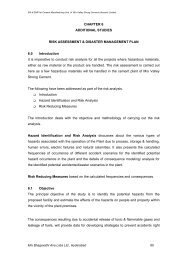
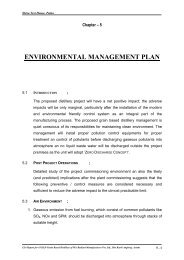
![a]ÝĖ^į %XĮ[ýįV - Pollution Control Board, Assam](https://img.yumpu.com/50573985/1/190x245/ayei-xiyiv-pollution-control-board-assam.jpg?quality=85)
